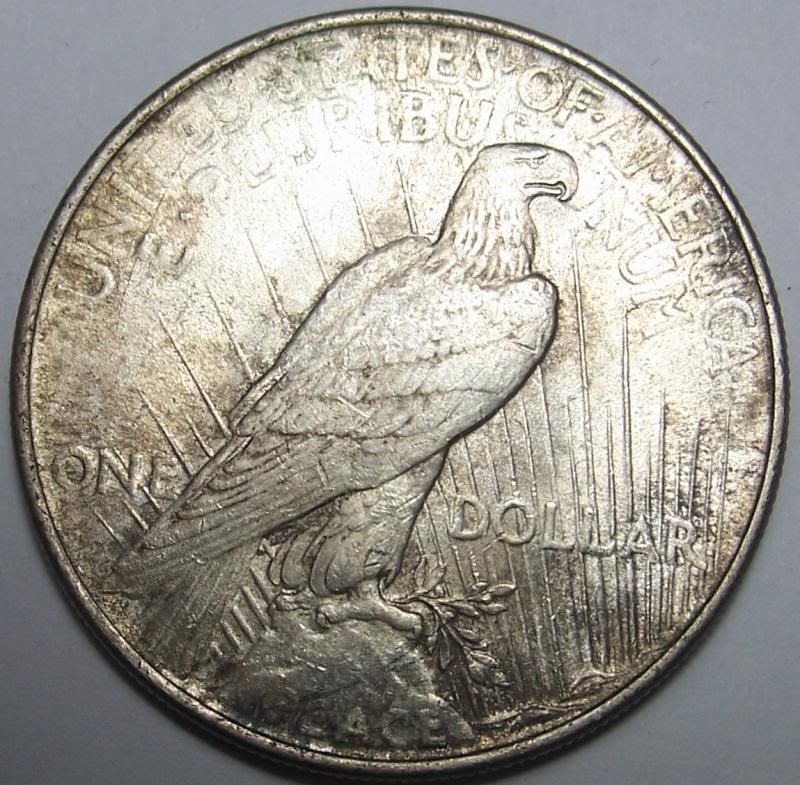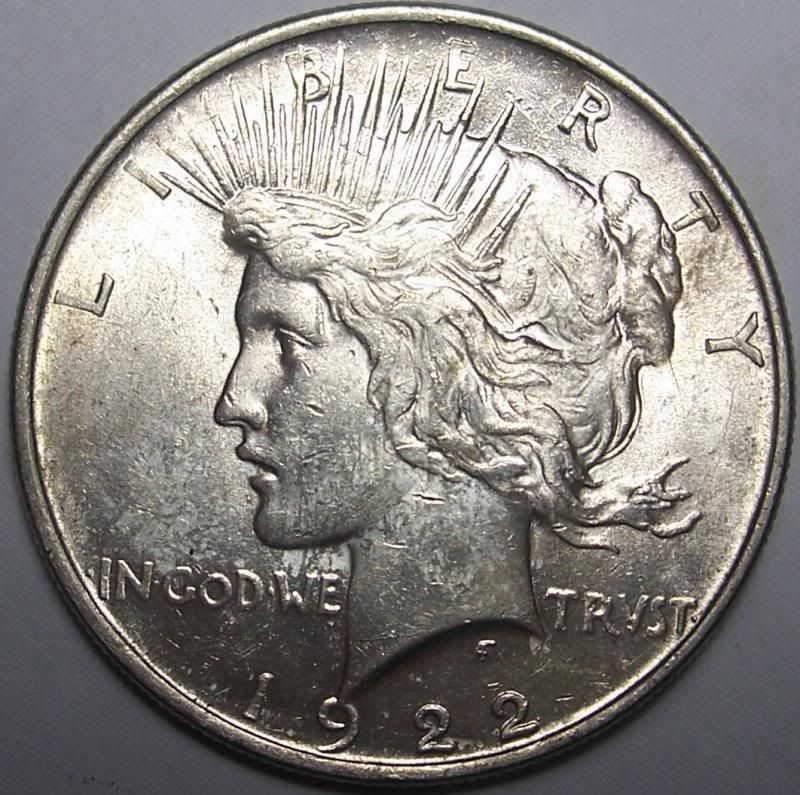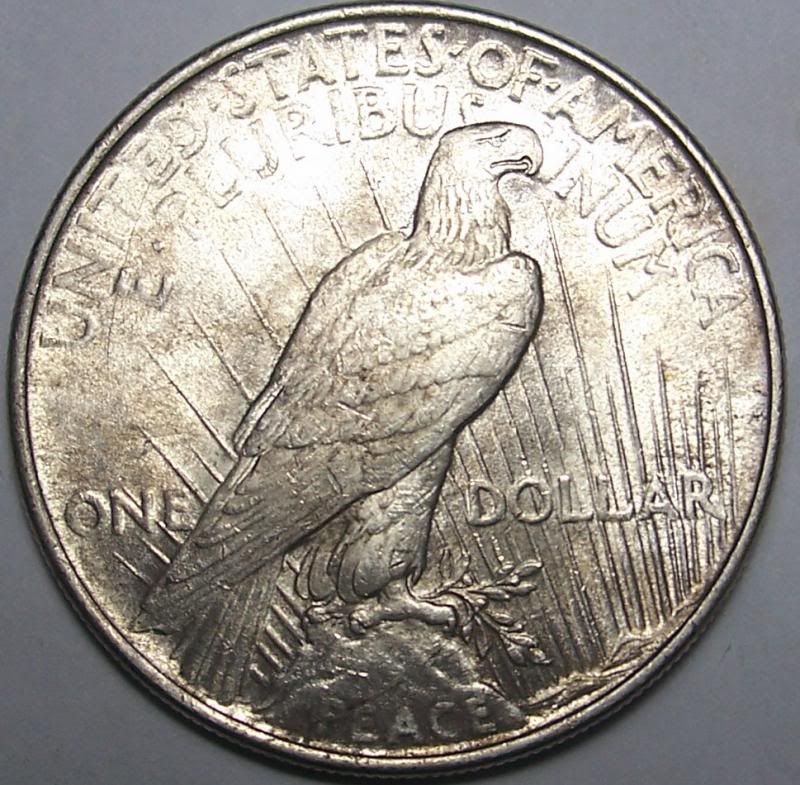Cleaning silver coins with baking soda?
I have heard about people doing this and always wondered why people would attempt cleaning a coin with an abrasive. But actually, that is NOT what you do. The correct method of cleaning a coin using baking soda is to place a coin in a vessel on top of a sheet of aluminium foil, boil some water and add the baking soda, then add the baking soda solution to the vessel. Here is a junk silver 1922 peace dollar (that my dad got when he was a kid from the bank) with some not so great toning:


Here it is, nearly blast white with decent boom to its luster (there is some haze that did not change, and the dark toning on the reverse is not as dark as it appears in the photo)


The luster actually booms rather nicely. A bit of the deeper tarnish remains, but its not bad. What actually happens is the battery effect. The baking soda reacts with the silver sulfide, turning the silver sulfide back into silver in a reaction with the aluminium. The equation:
3 Ag2S + 2 Al --/> 6 Ag + Al2S3
silver
sulfide aluminum silver aluminum sulfide
Fun with Chemistry!
Thoughts?


Here it is, nearly blast white with decent boom to its luster (there is some haze that did not change, and the dark toning on the reverse is not as dark as it appears in the photo)


The luster actually booms rather nicely. A bit of the deeper tarnish remains, but its not bad. What actually happens is the battery effect. The baking soda reacts with the silver sulfide, turning the silver sulfide back into silver in a reaction with the aluminium. The equation:
3 Ag2S + 2 Al --/> 6 Ag + Al2S3
silver
sulfide aluminum silver aluminum sulfide
Fun with Chemistry!
Thoughts?
0
Comments
Eric
If I sounded mean I apologize. I suppose I am jealous that you have a dollar your dad had. I do not.
Not realizing it was new, I scrubbed it up good w/baking soda paste.
Once I saw how much detail was there I sent it to ANACS where it graded MS63!!
And this was while Capn Henway was there!!!
Over a few week period of putting baking soda down the drain, the problem was solved.
My advice to the UNIVERSE at large. Do no clean coins. Period.
But they're your coins so in essence, God gave us a free will. (and even if you don't believe you can still exercise it, as you wish)
Do what makes you happy, just don't come crying to me when I tell you the "numismatic collectible value" is just not there (for me) anymore.
``https://ebay.us/m/KxolR5
<< <i>What actually happens is the battery effect. The baking soda reacts with the silver sulfide, turning the silver sulfide back into silver in a reaction with the aluminum.
The equation: 3 Ag2S + 2 Al --/> 6 Ag + Al2S3 silver sulfide aluminum silver aluminum sulfide >>
Know that part of the equation in removing or dissolving the dark silver sulfide by chemically reducing the silver sulfide back to metallic silver as you mentioned, also removes some of the metallic silver along with the silver sulfide.
The reduction reaction restores metallic silver:
3 e- + 3 Ag+ --> 3 Ag0 (s)
The aluminum oxidation reaction drives the reduction of silver:
Al0s --> Al+3 (aq) +3 e-
Combining these two half reactions gives us the complete redox reaction:
Al0 (s) + 3 Ag+ --> Al+3 + 3 Ag0 (s)
The reaction that causes the tarnish to form is what is called an oxidation reaction. In the case of the standard acidic dipping you are shifting the reaction back in the direction of the reduced oxidation state through the use of a more active oxidizer. Your baking soda and aluminum pot are doing the same thing but in a basic or high pH solution rather than an acidic or low pH solution. Both acid and base solutions can be corrosive and eventually will do damage to the surfaces of the coin.
The process here is electrolytic in nature though and not pH based. Based on electrochemical potentials and the difference in potential between silver sulfide and aluminum sulfide, an electron from the neutral aluminum metal travels through the sodium carbonate solution (for washing soda) or sodium bicarbonate (baking soda) to the silver sulfide which reduces the silver atom and frees the sulfur ion to react with the aluminum ion forming aluminum sulfide.
With this method however, you're breaking down the silver-sulfide ionic complex and reforming the silver metal. The silver metal will then show through again like it did originally, however, it won't be bonded to the bulk metal in the same matter so the same luster and shine will never be there again. At times, pitting occurs in the metal itself as it slowly breaks down. To sum everything up, the coin one starts with before this process, will never ever be the same coin after.
I have a stack of these, so using one is no big deal. It is a decent method for removing splotchy ugly toning on a coin that has good luster.
BHNC member # 184!
http://www.busthalfaddict.com
"A dog breaks your heart only one time and that is when they pass on". Unknown
Tarnish remover
BHNC member # 184!
http://www.busthalfaddict.com
These were Christmas gifts to Nephews and Nieces, and, they still cherish them after all these years.
Back then they did not cost much, saved me the hassle of shopping, and, after their toys broke, the batteries died, they out grew the toy, etc, they still have the SHINEY (not now, re-toned) SD's they were given.
I DID explain cleaning, collector value, toning and such.
A gift like that is one most kids keep forever, and pass along, as has since happened.
<< <i>
<< <i>What actually happens is the battery effect. The baking soda reacts with the silver sulfide, turning the silver sulfide back into silver in a reaction with the aluminum.
The equation: 3 Ag2S + 2 Al --/> 6 Ag + Al2S3 silver sulfide aluminum silver aluminum sulfide >>
Know that part of the equation in removing or dissolving the dark silver sulfide by chemically reducing the silver sulfide back to metallic silver as you mentioned, also removes some of the metallic silver along with the silver sulfide.
The reduction reaction restores metallic silver:
3 e- + 3 Ag+ --> 3 Ag0 (s)
The aluminum oxidation reaction drives the reduction of silver:
Al0s --> Al+3 (aq) +3 e-
Combining these two half reactions gives us the complete redox reaction:
Al0 (s) + 3 Ag+ --> Al+3 + 3 Ag0 (s)
The reaction that causes the tarnish to form is what is called an oxidation reaction. In the case of the standard acidic dipping you are shifting the reaction back in the direction of the reduced oxidation state through the use of a more active oxidizer. Your baking soda and aluminum pot are doing the same thing but in a basic or high pH solution rather than an acidic or low pH solution. Both acid and base solutions can be corrosive and eventually will do damage to the surfaces of the coin.
The process here is electrolytic in nature though and not pH based. Based on electrochemical potentials and the difference in potential between silver sulfide and aluminum sulfide, an electron from the neutral aluminum metal travels through the sodium carbonate solution (for washing soda) or sodium bicarbonate (baking soda) to the silver sulfide which reduces the silver atom and frees the sulfur ion to react with the aluminum ion forming aluminum sulfide.
With this method however, you're breaking down the silver-sulfide ionic complex and reforming the silver metal. The silver metal will then show through again like it did originally, however, it won't be bonded to the bulk metal in the same matter so the same luster and shine will never be there again. At times, pitting occurs in the metal itself as it slowly breaks down. To sum everything up, the coin one starts with before this process, will never ever be the same coin after. >>
Very impressive post. Well written, eruditional and easy to follow.
``https://ebay.us/m/KxolR5